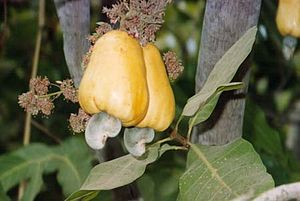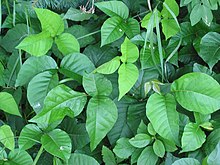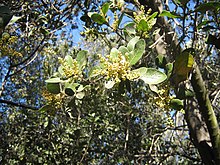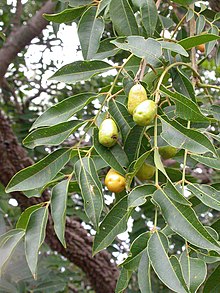Sumac family
| Sumac family | ||||||||||||
|---|---|---|---|---|---|---|---|---|---|---|---|---|

Cashew ( Anacardium occidentale ), |
||||||||||||
| Systematics | ||||||||||||
|
||||||||||||
| Scientific name | ||||||||||||
| Anacardiaceae | ||||||||||||
| ( R.Br. ) Lindl. |
The Sumac (Anacardiaceae; Engl. Cashew or sumac family ) form a plant family in the order of the soap tree-like (Sapindales). With around 70 to 82 genera and 600 to 800 species, they occur worldwide mainly in the tropics and subtropics , but sometimes also in temperate climates. Some species provide edible fruits and seeds - medicinal effects have been studied - and some are ornamental plants .
Description and ecology


Vegetative characteristics
They are mostly evergreen, woody plants: mostly they are independently upright trees or bushes , less often half bushes or they are lianas . Some species are herbaceous perennials . Many species have resin ducts with clear or milky resins that quickly turn black and have a typical ( turpentine ) resin odor. Wood, leaves and fruits can be aromatic or poisonous.
The usually alternate, rarely opposite or in whorls, often concentrated at the ends of branches, arranged leaves often smell aromatic. The leaf blade is undivided or often imparipinnate (exception is the paired pinnate Spondias bipinnata ). The edge of the leaves or pinnate leaves is entire. There is often black drawing on the leaves. Stipules are missing.
Inflorescences and flowers
Terminal or lateral, shamrock or panicle inflorescences are formed. The bracts are usually small, rarely large; in Dobinea they are membranous and fused with the flower stalks. The flowers are hermaphroditic or unisexual. The species can be monoecious ( monoecious ), dioecious ( dioecious ) separate sexes, gyno- dioecious or polygamomonoecan.
The relatively small flowers are radial symmetry and three to often five-fold. They have a double or single (sepalin and bract-like in Pistacia ) perianth . The bloom cladding sheets ( Dobinea ) are rarely missing . The three to five sepals are fused at the base. The three to five petals are free or rarely fused at the base. There are one ( Anacardium , Mangifera ) or two circles with five stamens each (rarely a total of twelve stamens). Either all stamens are fertile or there are one to nine staminodes . The ever slender stamens are sometimes fused at their base ( anacardium ). The anthers have four pollen sacs. It is a carpel present or two to five (rarely to six) fruit leaves are a syncarp, mostly upper constant, rarely half under constant up from constant ( Peyia , Semecarpus ) ovary grown in Dracontomelon they are not fully grown. Each ovary compartment contains an apotropic ovule . Often only one carpel is fully developed. The usually only style ends with one to five scars; sometimes three to six styles are also present ( Buchanania ). A mostly intrastaminal, nectar-producing disc is usually clearly developed. In many of the genera that are now included in this family, the flowers and inflorescences are greatly reduced. This resulted in them being run as families of their own. For example, the earlier Blepharocaryaceae have compact, involucre inflorescences, the dioecious separate-sexed Julianaceae and Podoaceae lack bracts in the female flowers. The wind-pollinated species usually lack a discus and bracts.
Infructescence, fruits, seeds and spread
Mostly stone fruits are formed, but there is a great abundance of fruit types in this family. The mechanisms of propagation are diverse. In two genera Anacardium and Semecarpus , a meaty, is edible Arillus (here called Hypokarp) formed under the stone fruit, which is formed from the fruit stem and the receptacle. Within the genus Anacardium , only Anacardium microsepalum is missing an aril ; this species thrives in water-flooded forests of the Amazon and is believed to be distributed by large fish. Water dispersal has also been reported in three other genera, Mangifera , Poupartiopsis and Spondias . To be spread by the wind, there are different adaptations, for example enlarged sepals ( Astronium , Loxostylis , Myracrodruon , Parishia ), enlarged permanent petals ( Gluta , Swintonia ), broad bracts ( Dobinea ), a wing formed from the flattened fruit axis becomes ( Amphipterygium ), and in some genera the edges of the fruits have hairs ( Actinocheita , Blepharocarya , Ochoterenaea ). Instead of stone fruits, samaras (wing nuts) are formed in some genera: in Campylopetalum , Cardenasiodendron , Dobinea , Laurophyllus , Pseudosmodingium , Smodingium , a membranous wing is formed around the entire edge of the fruit or in Faguetia , Loxopterygium , Schinopsis a wing on only one side. Amphipterygium , Orthopterygium form airworthy collective fruits (syncarpia). Dry, achenaic fruits are formed in Apterokarpos . With cotinus the infructescence with long hairy inflorescence axes is the distribution unit. These adaptations with drifting fruits seem to be associated with colonization of dry habitats . A dry fruit is formed at Dobinea . The epicarp is thin, the mesocarp is mostly fleshy, fibrous, and the endocarp is hard. The embryo is often curved.

Chromosomes and ingredients
On chromosome numbers were n = 7-12, 14-16, found 21st
About a quarter of all species, but all of the subfamily Anacardioideae, contain toxic dihydroxybenzenes with long unbranched side chains that cause skin irritation if the parts of the plant are touched. The endosperm is oily and sometimes starchy.

Occurrence
Species from the Anacardiaceae family are found in dry to humid areas worldwide. Mostly they thrive in humid lowland habitats . They are mainly found in the tropics and subtropics, but some species also extend into the temperate latitudes. In the New World the distribution ranges from Canada to Patagonia , there are occurrences in Africa, southern Europe, temperate to tropical Asia, tropical to subtropical Australia and on most of the Pacific islands. There are no species of this family in Northern Europe, temperate and dry Australia, New Zealand , on the Galapagos Islands , in extreme desert areas and at high altitudes; but they reach altitudes up to 3500 meters. The center of biodiversity is Malaysia .
Systematics
Taxonomy
In 1759, Bernard de Jussieu put the genera classified here today in a subordination of an order "Terebintaceae"; his nephew Antoine Laurent de Jussieu published this classification in Genera plantarum in 1789 : secundum ordines naturales disposita, juxta methodum in Horto regio parisiensi exaratam, anno M.DCC.LXXIV (Apud Viduam Herissant et Theophilum Barrois, Paris). Robert Brown edited the same genres in 1818 in the publication by John Murray on the expedition to the Congo led by James Kingston Tuckey and the herbarium created by Christians Smith . Augustine Pyramus de Candolle published in 1824, with Robert Brown's Cassuvlae or Anacardeae, another description of this kindred with the genera Anacardium , Semecarpus , Holigarna , Mangifera , Buchanania , Pistacia , Astronium , Comocladia and Picramnia . John Lindley presented a new description of this family group in 1831 with the Anacardieae and Sumachineae, giving the name "Terebintaceae" in favor of Anacardiaceae and adding the genera Anacardium , Holigarna , Mangifera , Rhus , Mauria . The type genus is Anacardium L.
The sumac family (Anacardiaceae) comprises four subfamilies with 70 to 82 genera and about 600 to 800 species .








Division of the family into subfamilies and their genera
According to Susan K. Pell 2004, the family is divided into two subfamilies and some tribes:
- Subfamily Anacardioideae Link (Syn .: Blepharocaryaceae Airy Shaw , Comocladiaceae Martynov , Julianaceae Hemsley , Lentiscaceae Horan. , Pistaciaceae Adanson , Podoaceae Franchet , Schinaceae Raf. , Vernicaceae Link ): There are 58 to 60 genera:
- Actinocheita F.A.Barkley : With 1-2 species which occur in Mexico.
- Amphipterygium Schiede ex Standl. (Syn .: Hypopterygium Schltdl. , Juliania Schltdl. ): With about four species that occur in Mexico and Peru .
-
Anacardium L .: The ten or so species arewidespreadin the Neotropic , including:
- Cashew ( Anacardium occidentale L. )
-
Androtium Stapf : There is only one type:
- Androtium astylum Stapf : It occurs in Malesia .
-
Apterokarpos Rizzini : There is only one type:
- Apterokarpos gardneri (Engl.) Rizzini : It occurs in Brazil .
- Astronium Jacq. : With about 15 species found in tropical America.
-
Baronia Baker : There is only one type:
- Baronia taratana Baker : It occurs in Madagascar .
- Blepharocarya F. Muell. : With about two species that occur in northeastern Australia.
-
Bonetiella Rzed. : There is only one type:
- Bonetiella anomala (IMJohnst.) Rzed. : It occurs in Mexico.
- Bouea Meisn. : With about three species that occur in Southeast Asia and Malesia.
- Buchanania Explosion. : The 25 or so species are common in tropical Asia.
- Campnosperma Thwaites : The five or so species occur in Madagascar .
-
Campylopetalum Forman : There is only one species:
- Campylopetalum siamense Forman : It occurs in Thailand .
-
Cardenasiodendron F.A. Barkley : There is only one species:
- Cardenasiodendron brachypterum (Loes.) FABarkley : It occurs in Bolivia .
- Comocladia P.Browne : With about 20 species that occur in tropical America.
- Wig bushes ( Cotinus Mill. ): There are about four species found in the northern hemisphere :
- Dobinea Buch.-Ham. ex D.Don : The only two species are distributed from the eastern Himalaya region to south-western China.
- Drimycarpus Hook.f. : The only two types are common in China , India , Myanmar , Nepal and Vietnam .
- Euroschinus Hook.f. : With about six species. They are found in Malesia, Australia and New Caledonia.
-
Faguetia Marchand : There is only one species:
- Faguetia falcata Marchand : This endemic occurs in Madagascar only in the Toamasina province.
- Fegimanra Pierre : With about two species that occur in tropical Africa.
- Gluta L .: with about 30 species that occur in Indomalesia and Madagascar.
-
Haplorhus Engl .: With only one species:
- Haplorhus peruviana Engl .: It occurs in the Andes of Peru and northern Chile .
-
Heeria Meisn. : There is only one type:
- Heeria argentea Meisn. : The home is the Capensis .
- Holigarna Buch.-Ham. ex Roxb. : With about 8 species that occur in Indomalesia.
-
Laurophyllus Thunb. : There is only one type:
- Laurophyllus capensis Thunb. : It occurs in the South African provinces of the Western and Eastern Cape .
- Lithraea Miers ex Hook. & Arn. : With about three species that occur in South America.
- Loxopterygium Hook.f. : With about three species that occur in tropical South America.
-
Loxostylis A. Spreng . ex Rchb. : With only one type:
- Loxostylis alata A. Spreng . ex Rchb. : It occurs in southern Africa.
- Mangos ( Mangifera L. ): The approximately 69 species are common in tropical Asia.
- Mauria Kunth : The ten or so species thrive in mountainous regions of the Neotropic.
- Melanochyla Hook.f. : With about 30 species that occur in Malesia.
- Metopium P.Browne : With about three species that occur in Florida , Mexico and the Caribbean.
- Micronychia olive. : Since 2009 there have been around ten species that are unique to Madagascar.
-
Mosquitoxylum Krug & Urb. : There is only one type:
- Mosquitoxylum jamaicense Jug & Urb. : It occurs in Jamaica .
- Nothopegia flower : With about seven kinds that occur in India and Sri Lanka .
-
Ochoterenaea F.A.Barkley : There is only one way:
- Ochoterenaea colombiana F.A.Barkley : It comes in Columbia before.
-
Orthopterygium Hemsl. : There is only one type:
- Orthopterygium huaucui (A. Gray) Hemsl. (Syn .: Juliania huaucui A.Gray ): The home is Peru .
- Ozoroa Delile : The 40 or so species are common in Africa and the Arabian Peninsula .
-
Pachycormus Coville ex Standl. : With only one type:
- Pachycormus discolor (Benth.) Standl. : It occurs in Baja California .
- Parishia Hook.f. : With about seven species that occur in Indomalesia.
- Pentaspadon Hook.f. : With about six species that occur from Southeast Asia to Papua Asia.
- Pistachios ( Pistacia L. ): The ten or so species are common in the northern hemisphere.
- Protorhus Engl .: The 20 or so species occur mainly in Madagascar, but a species also in the Capensis.
- Pseudosmodingium Engl .: With about seven species that occur in Mexico.
-
Rhodosphaera Engl .: There is only one kind:
- Rhodosphaera rhodanthema (F.Muell.) Engl .: It occurs in northeastern Australia.
-
Rhus L . (including Searsia F.A.Barkley , Toxicodendron Mill. ): There are 150 to 250 species, including:
- Vinegar tree , also called sumac, (Syn .: Rhus typhina L .; Syn .: Rhus hirta (L.) Sudw. )
- Gerber sumac ( Rhus coriaria L. )
- Spice Sumach ( Rhus aromatica Ait. )
- Oak-leaved poison oak ( Rhus toxicodendron L. )
- Poisonous climbing sumac ( Rhus radicans L. )
- Rhus diversiloba Torr. & A.Gray (Syn: Toxicodendron diversilobum (Torr. & A.Gray) Greene )
- Lacquer Tree ( Rhus verniciflua Stokes )
- Schinopsis Engl .: With about seven kinds that occur in South America.
- Pepper trees ( Schinus L. ): The approximately 25 species are widespread in the Neotropic.
- Semecarpus L.f. : The 50 to 60 species arewidespreadfrom tropical Asia to Oceania .
-
Smodingium E. Mey . ex Sond. : There is only one type:
- Smodingium argutum E. Mey . ex Sond. : The home is the Capensis.
-
Sorindeia Thouars : With around nine species that occur in tropical Africa, Madagascar and the Mascarene Islands .
- Sorindeia madagascariensis DC. : From Madagascar, the Comoros and Mascarene Islands and the African east coast from Somalia to Mozambique.
- Swintonia handle. : With about 13 species found in Indomalesia.
- Thyrsodium Saltm . ex Benth. : With about seven species found in tropical America.
-
Trichoscypha Hook.f. : With about 50 species that occur in tropical Africa.
- Trichoscypha acuminata Engl .: From western central Africa to Nigeria .
- Subfamily Spondioideae Link (Syn .: Spondiadaceae): There are 10 to 18 genera with about 115 species:
- Antrocaryon Pierre : With about 2-3 species in tropical West Africa and one species in tropical America.
-
Choerospondias B.L.Burtt & AWHill : There is only one type:
- Choerospondias axillaris (Roxb.) BLBurtt & AWHill : It is distributed in Cambodia , southern China, Taiwan to Tibet and Nepal, Laos , Thailand and Vietnam.
-
Cyrtocarpa Kunth : The five or so species are common in the Neotropic.
- Cyrtocarpa procera Kunth : From Mexico.
- Dracontomelon flower : The eight or so species are distributed in tropical Asia and Indomalesia to Fiji .
- Haematostaphis Hook.f. : With about two species that occur in tropical West Africa.
-
Harpephyllum Bernh. ex C. Krauss : There is only one type:
- Harpephyllum caffrum Bernh. ex C. Krauss : It is native to South Africa and is a widespread ornamental plant for tropical to subtropical parks and gardens, but is also a robust houseplant.
- Koordersiodendron Engl .: With up to three species that occur in Indonesia, the Philippines and New Guinea .
- Lannea A. Rich. : The 40 to 70 species are widespread in tropical Africa, southern and south-eastern Asia.
- Operculicarya H.Perrier : There are about nine species, eight of which are only found in Madagascar and one is also found in the Comoros and Seychelles.
- Pegia Colebr. : The approximately three species are distributed from the eastern Himalaya region to the Indochinese Peninsula and Kalimantan .
-
Pleiogynium Engl .: With about 2-3 species that occur in Malesia and on islands in the Pacific.
- Pleiogynium timoriense (DC.) Leenh. : From northeastern Australia, New Guinea, the Solomon Islands to Polynesia .
- Poupartia Comm. ex Juss. : There are about 17 species found in tropical Africa, Madagascar and India.
-
Poupartiopsis Capuron ex JDMitch. & Daly : There is only one way:
- Poupartiopsis spondiocarpus Capuron ex JDMitch. & Daly : It occurs in Madagascar.
-
Pseudospondias Engl .: With about two kinds that occur in western and tropical Africa.
- Pseudospondias microcarpa (A.Rich.) Engl .: From West and Central Africa to Uganda , Tanzania , Zambia and Sudan .
-
Sclerocarya Hochst. : The only two species are found in Africa and Madagascar, including:
- Marula tree ( Sclerocarya birrea (A.Rich.) Hochst. )
- Solenocarpus Wight & Arn. (sometimes in Spondias L. ): With 1-2 species that occur in India and the Philippines.
- Spondias L .: The ten to eleven species are common in the Neotropic and tropical Asia (e.g. Umbú ).
- Tapirira Aubl. : With about 10 species found in tropical America.

use
Some species and their varieties are grown worldwide (in the tropics). They are used to extract edible fruits and seeds, to extract spices (as is the case with gerber sumac ), as a raw material for pharmaceutical products and wood. Some species are used as ornamental plants. Known worldwide are: Mango ( Mangifera indica ), Pistachio ( Pistacia vera ), Cashew ( Anacardium occidentale ) and Brazilian pepper tree ( Schinus terebinthifolia ). Other crops are only widespread in their pantropical growing areas, such as the Spondias fruits, the Marula ( Sclerocarya birrea ) in Africa or the Antrocaryon fruits in the Neotropics . Their marketing is restricted due to their poor transportability.
swell
- Susan K. Pell: Anacardiaceae : entry, in 2009 the Tree of Life project. (Sections Description, Distribution, Use)
- The Anacardiaceae family on the AP website . (Sections Description and Systematics)
- The family of Anacardiaceae , the family of Podoaceae , the family of Pistaciaceae , the family of Julianaceae and the family of Blepharocaryaceae at DELTA L. Watson and MJ Dallwitz. (accessed March 2010)
- Tianlu Min, Anders Barfod: Anacardiaceae. , P. 335 - online with the same text as the printed work , In: Wu Zheng-yi, Peter H. Raven, Deyuan Hong (Ed.): Flora of China. Volume 11: Oxalidaceae through Aceraceae. Science Press and Missouri Botanical Garden Press, Beijing and St. Louis 2008, ISBN 978-1-930723-73-3 . (Sections Description and Systematics)
Individual evidence
- ↑ Genera plantarum ... , 1789, pp. 368-369.
- ↑ Genera plantarum: secundum ordines naturales disposita, juxta methodum in Horto regio parisiensi exaratam, anno M.DCC.LXXIV
- ↑ James Kingston Tuckey: Observations, Systematical and Geographical, on Professor Christian Smith's Collection of Plants from the Vicinity of the River Congo in Narrative of an Expedition to Explore the River Zaire Usually Called the Congo, in South Africa, in 1816, Under the Direction of Captain JK Tuckey, RN, to Which is Added, the Journals of Professor Smith; Some General Observations on the Country and its Inhabitants; and an Appendix: Containing the Natural History of that Part of the Kingdom Congo Through Which the Zaire Flows , London.
- ^ Expedition ... (1818) Appendix V, pp. 430–431.
- ↑ Prodromus Systematis Naturalis 1824, pp. 62-66.
- ^ John Lindley in John Torrey: An Introduction to the Natural System of Botany: or A Systematic View of the Organization, Natural Affinities, and Geographical Distribution of the Whole Vegetable Kingdom; Together with the Uses of the Most Important Species in Medicine, the Arts and Rural or Domestic Economy , in G. & C. & H. Carvill: Natural System of Botany , New York City, pp. 125-127.
- ↑ Susan K. Pell: Molecular Systematics of the Cashew Family (Anacardiaceae) , PhD Thesis, 2004, Louisiana State University.
- ↑ a b c d e f g h i j k l m n o p q r s t u v w x y z aa ab ac ad ae af ag ah ai aj ak al am an ao ap aq ar as at David John Mabberley : Mabberley's Plant-Book. A portable dictionary of plants, their classification and uses . 3rd ed. Cambridge University Press 2008. ISBN 978-0-521-82071-4
- ↑ a b c d e Anacardiaceae at Tropicos.org. In: Catalog of the Vascular Plants of Madagascar . Missouri Botanical Garden, St. Louis
- ↑ a b c d Anacardiaceae in the Germplasm Resources Information Network (GRIN), USDA , ARS , National Genetic Resources Program. National Germplasm Resources Laboratory, Beltsville, Maryland.
- ^ JD Mitchell, Douglas C. Daly: Cyrtocarpa (Anacardiaceae) in South America. In: Annals of the Missouri Botanical Garden , Volume 78, 1991, pp. 184-189.
- ↑ John D. Mitchella, Douglas C. Daly, Susan K. Pellac, and Armand Randrianasolo: Poupartiopsis gen. Nov. and its Context in Anacardiaceae Classification. In: Systematic Botany , Volume 31, Issue 2, 2006, pp. 337-348.
further reading
- JD Mitchell, SA Mori: The cashew and its relatives (Anacardium: Anacardiaceae). In: Mem. NY Bot. Gard. , 42, 1987, pp. 1-76.
- BS Wannan: Floral structure and evolution in the Anacardiaceae. In: Botanical Journal of the Linnean Society , 107, 1991, pp. 349-85.
- T. Terrazas: Wood anatomy of the Anacardiaceae: ecological and phylogenetic interpretation , Ph.D. dissertation, Chapel Hill, NC: University of North Carolina, 1994.
Web links
- Yasin J. Nasir: Description of the family with a scope of only 55 genera in the Flora of Pakistan . (accessed March 2010)
- Anacardiaceae (Mango, Pepper tree, Pistachio, Cashew family) at the Biodiversity Explorer - Iziko (section systematics)
- Photos and description of Amphipterygium adstringens at www.ethno-botanik.org .
- Anacardiaceae at Tropicos.org. Missouri Botanical Garden, St. Louis, Retrieved June 7, 2017.
- Anacardiaceae at Tropicos.org. In: Flora of Pakistan . Missouri Botanical Garden, St. Louis
- Anacardiaceae at Tropicos.org. In: Flora de Nicaragua . Missouri Botanical Garden, St. Louis
- Anacardiaceae at Tropicos.org. In: Flora Mesoamericana . Missouri Botanical Garden, St. Louis
- Anacardiaceae at Tropicos.org. In: IPCN Chromosome Reports . Missouri Botanical Garden, St. Louis
- Anacardiaceae at Tropicos.org. In: Flora of Panama (WFO) . Missouri Botanical Garden, St. Louis

